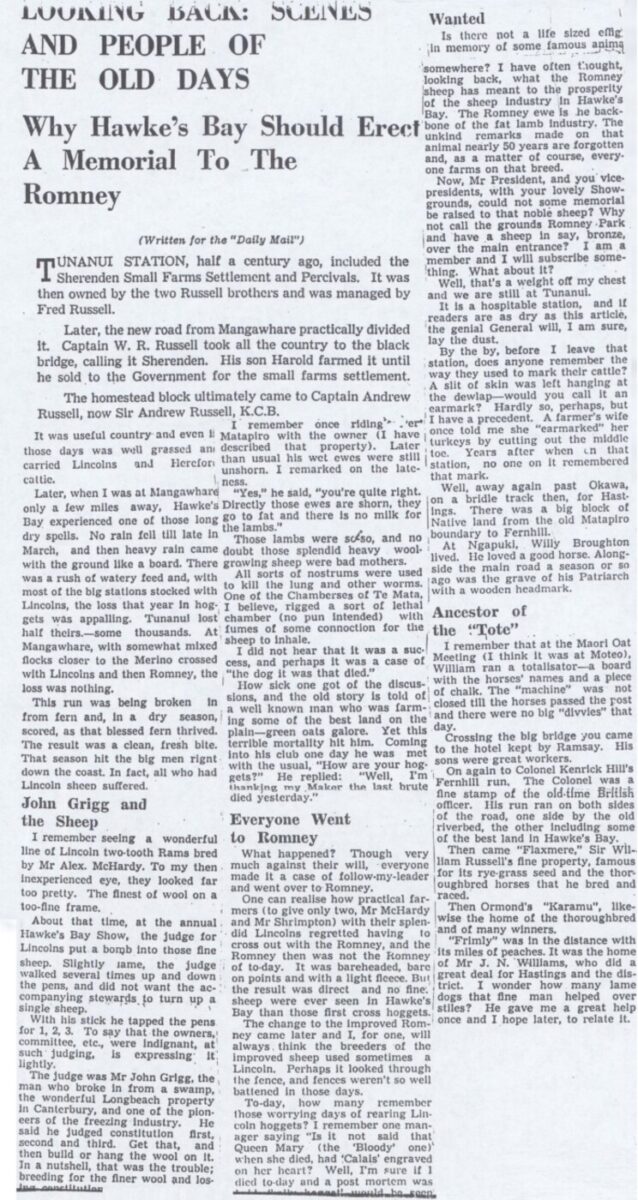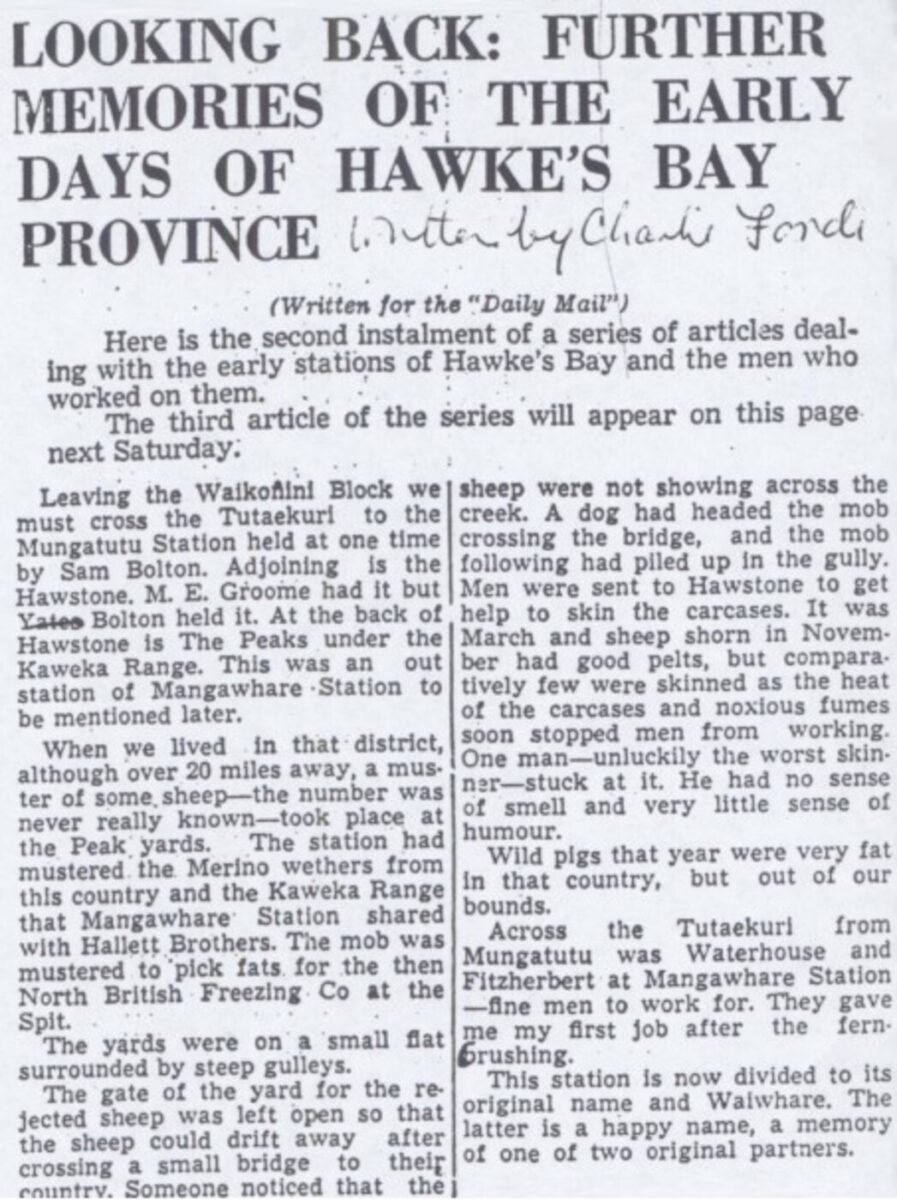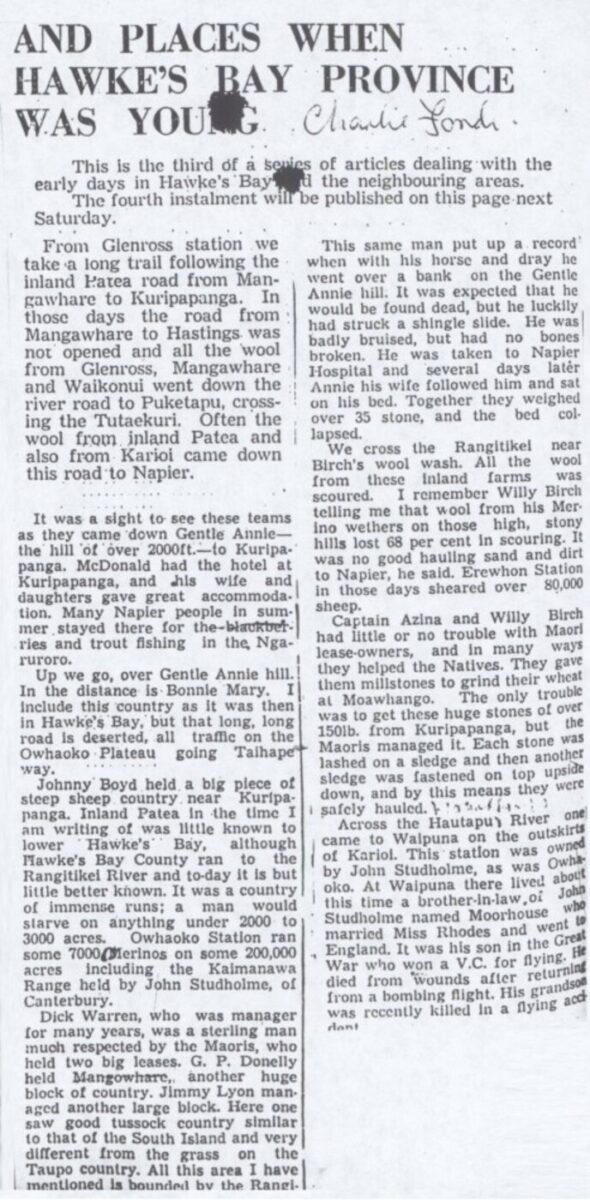LOOKING BACK: SCENES AND PEOPLE OF THE OLD DAYS
Why Hawke’s Bay Should Erect A Memorial To The Romney
(Written for the “Daily Mail”)
TUNANUI STATION, half a century ago, included the Sherenden Small Farms Settlement and Percivals. It was then owned by the two Russell brothers and was managed by Fred Russell.
Later, the new road from Mangawhare practically divided it. Captain W. R. Russell took all the country to the black bridge, calling it Sherenden. His son Harold farmed it until he sold to the Government for the small farms settlement.
The homestead block ultimately came to Captain Andrew Russell, now Sir Andrew Russell, K.C.B.
It was useful country and even in those days was well grassed and carried Lincolns and Hereford cattle.
Later, when I was at Mangawhare only a few miles away, Hawke’s Bay experienced one of those long dry spells. No rain fell till late in March, and then heavy rain came with the ground like a board. There was a rush of watery feed and, with most of the big stations stocked with Lincolns, the loss that year in hoggets was appalling. Tunanui lost half theirs. Some thousands. At Mangawhare, with somewhat mixed flocks closer to the Merino crossed with Lincolns and then Romney, the loss was nothing.
This run was bring broken in from fern and, in a dry season, scored, as that blessed fern thrived. The result was a clean, fresh bit. That season hit the big men right down the coast. In fact, all who had Lincoln sheep suffered.
John Grigg and the Sheep
I remember seeing a wonderful line of Lincoln two-tooth Rams bred by Mr Alex. McHardy. To my then inexperienced eye, they looked far too pretty. The finest of wool on a too-fine frame.
About that time, at the annual Hawke’s Bay Show, the judge for Lincolns put a bomb into those fine sheep. Slightly lame, the judge walked several times up and down the pens, and did not want the accompanying stewards to turn up a single sheep.
With his stick he tapped the pens for 1, 2, 3. To say that the owners, committee, etc., were indignant, at such judging, is expressing it lightly.
The judge was Mr John Grigg, the man who broke in from a swamp, the wonderful Longbeach property in Canterbury, and one of the pioneers of the freezing industry. He said he judged constitution first, second and third. Get that, and then build or hang the wool on it. In a nutshell, that was the trouble; breeding for the finer wool and losing constitution.
I remember once riding over Matapiro with the owner (I have described that property). Later than usual his wet ewes were still unshorn. I remarked on the lateness.
“Yes,” he said, “you’re quite right. Directly those ewes are shorn, they go to fat and there is no milk for the lambs.”
Those lambs were so-so, and no doubt those splendid heavy wool-growing sheep were bad mothers.
All sorts of nostrums were used to kill the lung and other worms. One of the Chamberses [Chambers] of Te Mata, I believe, rigged a sort of lethal chamber (no pun intended) with fumes of some connoction [concoction] for the sheep to inhale.
I did not hear that it was a success, and perhaps it was a case of “the dog it was that died.”
How sick one got of the discussions, and the old story is told of a well known man who was farming some of the best land on the plain green oats galore. Yet this terrible mortality hit him. Coming into his club one day he was met with the usual, “How are your hoggets?” He replied: “Well, I’m thanking my Maker the last brute died yesterday.”
Everyone Went to Romney
What happened? Though very much against their will, everyone made it a case of follow-my-leader and went over to Romney.
One can realise how practical farmers (to give only two, Mr McHardy and Mr Shrimpton) with their splendid Lincolns regretted having to cross out with the Romney, and the Romney then was not the Romney of to-day. It was bareheaded, bare on points and with a light fleece. But the result was direct and no finer sheep were ever seen in Hawke’s Bay than those first cross hoggets.
The change to the improved Romney came later and I, for one, will always think the breeders of the improved sheep used sometimes a Lincoln. Perhaps it looked through the fence, and fences weren’t so well battened in those days.
Today, how many remember those worrying days of rearing Lincoln hoggets? I remember one manager saying “Is it not said that Queen Mary (the ‘Bloody’ one) when she died, had ‘Calais’ engraved on her heart? Well, I’m sure if I died today and a post mortem was held “hogget” heart would be seen somewhere?
Wanted
Is there not a life sized effigy in memory of some famous animal somewhere? I have often thought, looking back, what the Romney sheep has meant to the prosperity of the sheep industry in Hawke’s Bay. The Romney ewe is he [the] backbone of the fat lamb industry. The unkind remarks made on that animal nearly 50 years are forgotten and, as a matter of course, everyone farms on that breed.
Now, Mr President, and you vice-presidents, with your lovely Showgrounds, could not some memorial be raised to that noble sheep? Why not call the grounds Romney Park and have a sheep in say, bronze, over the main entrance? I am a member and I will subscribe something. What about it?
Well, that’s a weight off my chest and we are still in Tunanui.
It is a hospitable station, and if readers are as dry as this article, the genial General will, I am sure, lay the dust.
By the by, before I leave that station does anyone remember the way they used to mark their cattle? A slit of skin was left hanging at the dewlap would you call it an earmark? Hardly so, perhaps, but I have a precedent. A farmer’s wife once told me she “earmarked” her turkeys by cutting out the middle toe. Years after when on that station, no one on it remembered that mark.
Well, away again past Okawa, on a bridle track then, for Hastings. There was a big block of Native land from the old Matapiro boundary to Fernhill.
At Ngapuki, Willy Broughton lived. He loved a good horse. Alongside the main road a season or so ago was the grave of his Patriarch with a wooden headmark.
Ancestor of the “Tote”
I remember that at the Maori Oat Meeting (I think it was at Moteo), William ran a totalisator board with the horses’ names and a piece of chalk. The ‘machine’ was not closed till the horses passed the post and there were no big “divvies” that day.
Crossing the big bridge you came to the hotel kept by Ramsay. His sons were great workers.
On again to Colonel Kenrick Hill’s Fernhill run. The Colonel was a fine stamp of the old-time British officer. His run ran on both sides of the road, one side by the old riverbed, and the other including some of the best land in Hawke’s Bay.
Then came “Flaxmere,” Sir William Russell’s fine property, famous for its rye-grass seed and the thoroughbred horses that he bred and raced.
Then Ormond’s “Karamu”, likewise the home of the thoroughbred and of many winners.
“Frimly” [“Frimley”] was in the distance with its miles of peaches. It was the home of Mr J. N. Williams, who did a great deal for Hastings and the district. I wonder how many lame dogs that fine man helped over stiles? He gave me a great help once and I hope later, to relate it.














Do you know something about this record?
Please note we cannot verify the accuracy of any information posted by the community.